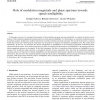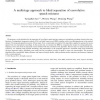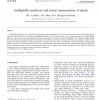SPEECH
2011
13 years 6 months ago
2011
We describe a system for separating multiple sources from a two-channel recording based on interaural cues and prior knowledge of the statistics of the underlying source signals. ...
SPEECH
2011
13 years 6 months ago
2011
This article deals with the generation of auditory-inspired spectro-temporal features aimed at audio coding. To do so, we first generate sparse audio representations we call spik...
SPEECH
2011
13 years 6 months ago
2011
This paper first introduces a newly-recorded high quality Romanian speech corpus designed for speech synthesis, called “RSS”, along with Romanian front-end text processing mo...
SPEECH
2011
13 years 6 months ago
2011
In this paper our aim is to investigate the properties of the modulation domain and more specifically, to evaluate the relative contributions of the modulation magnitude and phas...
SPEECH
2011
13 years 6 months ago
2011
We propose a novel algorithm for the separation of convolutive speech mixtures using two-microphone recordings, based on the combination of independent component analysis (ICA) an...
SPEECH
2011
13 years 6 months ago
2011
Typical speech enhancement methods, based on the short-time Fourier analysis-modification-synthesis (AMS) framework, modify only the magnitude spectrum and keep the phase spectru...
SPEECH
2011
13 years 6 months ago
2011
SPEECH
2011
13 years 6 months ago
2011
This study aims at uncovering perceptually-relevant acoustic cues for the labial versus alveolar place of articulation distinction in syllable-initial plosives {/b/,/d/,/p/,/t/} a...
SPEECH
2011
13 years 6 months ago
2011
Intelligibility predictors tell us a great deal about human speech perception, in particular which acoustic factors strongly effect human behavior, and which do not. A particular...
SPEECH
2011
13 years 6 months ago
2011



